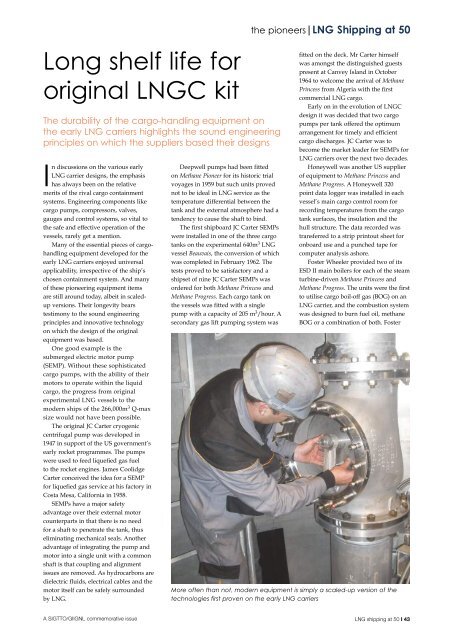You also want an ePaper? Increase the reach of your titles
YUMPU automatically turns print PDFs into web optimized ePapers that Google loves.
Long shelf life for<br />
original LNGC kit<br />
The durability of the cargo-handling equipment on<br />
the early LNG carriers highlights the sound engineering<br />
principles on which the suppliers based their designs<br />
In discussions on the various early<br />
LNG carrier designs, the emphasis<br />
has always been on the relative<br />
merits of the rival cargo containment<br />
systems. Engineering components like<br />
cargo pumps, compressors, valves,<br />
gauges and control systems, so vital to<br />
the safe and effective operation of the<br />
vessels, rarely get a mention.<br />
Many of the essential pieces of cargohandling<br />
equipment developed for the<br />
early LNG carriers enjoyed universal<br />
applicability, irrespective of the ship’s<br />
chosen containment system. And many<br />
of these pioneering equipment items<br />
are still around today, albeit in scaledup<br />
versions. Their longevity bears<br />
testimony to the sound engineering<br />
principles and innovative technology<br />
on which the design of the original<br />
equipment was based.<br />
One good example is the<br />
submerged electric motor pump<br />
(SEMP). Without these sophisticated<br />
cargo pumps, with the ability of their<br />
motors to operate within the liquid<br />
cargo, the progress from original<br />
experimental LNG vessels to the<br />
modern ships of the 266,000m 3 Q-max<br />
size would not have been possible.<br />
The original JC Carter cryogenic<br />
centrifugal pump was developed in<br />
1947 in support of the US government’s<br />
early rocket programmes. The pumps<br />
were used to feed liquefied gas fuel<br />
to the rocket engines. James Coolidge<br />
Carter conceived the idea for a SEMP<br />
for liquefied gas service at his factory in<br />
Costa Mesa, California in 1958.<br />
SEMPs have a major safety<br />
advantage over their external motor<br />
counterparts in that there is no need<br />
for a shaft to penetrate the tank, thus<br />
eliminating mechanical seals. Another<br />
advantage of integrating the pump and<br />
motor into a single unit with a common<br />
shaft is that coupling and alignment<br />
issues are removed. As hydrocarbons are<br />
dielectric fluids, electrical cables and the<br />
motor itself can be safely surrounded<br />
by LNG.<br />
Deepwell pumps had been fitted<br />
on Methane Pioneer for its historic trial<br />
voyages in 1959 but such units proved<br />
not to be ideal in LNG service as the<br />
temperature differential between the<br />
tank and the external atmosphere had a<br />
tendency to cause the shaft to bind.<br />
The first shipboard JC Carter SEMPs<br />
were installed in one of the three cargo<br />
tanks on the experimental 640m 3 LNG<br />
vessel Beauvais, the conversion of which<br />
was completed in February 1962. The<br />
tests proved to be satisfactory and a<br />
shipset of nine JC Carter SEMPs was<br />
ordered for both Methane Princess and<br />
Methane Progress. Each cargo tank on<br />
the vessels was fitted with a single<br />
pump with a capacity of 205 m 3 /hour. A<br />
secondary gas lift pumping system was<br />
the pioneers|LNG Shipping at 50<br />
fitted on the deck. Mr Carter himself<br />
was amongst the distinguished guests<br />
present at Canvey Island in October<br />
1964 to welcome the arrival of Methane<br />
Princess from Algeria with the first<br />
commercial LNG cargo.<br />
Early on in the evolution of LNGC<br />
design it was decided that two cargo<br />
pumps per tank offered the optimum<br />
arrangement for timely and efficient<br />
cargo discharges. JC Carter was to<br />
become the market leader for SEMPs for<br />
LNG carriers over the next two decades.<br />
Honeywell was another US supplier<br />
of equipment to Methane Princess and<br />
Methane Progress. A Honeywell 320<br />
point data logger was installed in each<br />
vessel’s main cargo control room for<br />
recording temperatures from the cargo<br />
tank surfaces, the insulation and the<br />
hull structure. The data recorded was<br />
transferred to a strip printout sheet for<br />
onboard use and a punched tape for<br />
computer analysis ashore.<br />
Foster Wheeler provided two of its<br />
ESD II main boilers for each of the steam<br />
turbine-driven Methane Princess and<br />
Methane Progress. The units were the first<br />
to utilise cargo boil-off gas (BOG) on an<br />
LNG carrier, and the combustion system<br />
was designed to burn fuel oil, methane<br />
BOG or a combination of both. Foster<br />
More often than not, modern equipment is simply a scaled-up version of the<br />
technologies first proven on the early LNG carriers<br />
A SIGTTO/GIIGNL commemorative issue LNG shipping at 50 I 43


